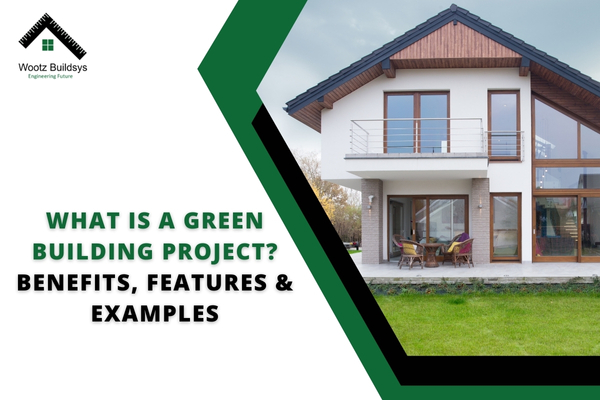
The construction industry is undergoing a major shift towards sustainability, and at the heart of this movement is the concept of a green building project. With growing awareness of climate change, energy efficiency, and environmental conservation, developers, architects, and governments are turning to green building solutions as the way forward.
But what exactly is a green building project? What makes it different from traditional construction, and why is it becoming so important? Let’s explore.
What Is a Green Building Project?
A green building project is a construction initiative designed and built using environmentally responsible and resource-efficient processes. The goal is to reduce negative impacts on the environment while improving the health, comfort, and productivity of the people using the building.
Unlike conventional buildings, green buildings focus on:
- Using sustainable materials
- Conserving water and energy
- Reducing waste and emissions
- Creating healthy indoor environments
Green building projects are not limited to new construction; existing buildings can also be retrofitted with green technologies and practices to improve sustainability.
Key Features of a Green Building Project
To qualify as “green,” a building must incorporate several important features. Some of the most common include:
1. Energy Efficiency
Green buildings integrate renewable energy sources like solar panels, wind turbines, and energy-efficient HVAC systems to reduce dependence on fossil fuels.
2. Sustainable Materials
Eco-friendly materials such as bamboo, recycled steel, reclaimed wood, and low-VOC paints are used in construction to minimize environmental impact.
3. Water Conservation
Features like rainwater harvesting, greywater recycling, and low-flow fixtures ensure water is conserved and reused efficiently.
4. Waste Reduction
During both construction and operation, waste is minimized through recycling and sustainable design practices.
5. Indoor Environmental Quality
Green buildings prioritize healthy indoor air with proper ventilation, natural lighting, and non-toxic building materials.
6. Smart Design & Layout
Architectural designs maximize natural light, airflow, and thermal comfort, reducing the need for artificial heating, cooling, and lighting.
Benefits of a Green Building Project
The rise of green building projects is fueled by the wide-ranging benefits they provide to both people and the planet.
1. Environmental Benefits
- Reduced carbon footprint
- Lower greenhouse gas emissions
- Conservation of natural resources
- Better waste management
2. Economic Benefits
- Lower operating costs due to reduced energy and water usage
- Higher property values and rental demand
- Government tax incentives and green certification benefits
3. Health & Social Benefits
- Improved indoor air quality reduces health risks
- Natural lighting boosts productivity and well-being
- Noise reduction creates a better working and living environment
4. Long-Term Value
Green buildings often outperform traditional ones in terms of durability, efficiency, and adaptability to future technologies.
Examples of Green Building Projects Around the World
Here are some globally recognized green building projects that showcase innovation and sustainability in action:
1. The Edge, Amsterdam (Netherlands)
Often called the world’s greenest office building, The Edge uses smart technology, solar energy, and rainwater harvesting to create an ultra-efficient workspace.
2. One Central Park, Sydney (Australia)
This residential and commercial development features vertical gardens, a water recycling plant, and heliostat technology to maximize natural light.
3. CII-Sohrabji Godrej Green Business Centre, Hyderabad (India)
A pioneer in India’s green building movement, this center incorporates energy-efficient systems, solar power, and sustainable landscaping.
4. Bullitt Center, Seattle (USA)
Known as the “greenest commercial building in the world,” the Bullitt Center runs entirely on renewable energy and is designed to last 250 years.
The Future of Green Building Projects
With increasing global demand for sustainable infrastructure, green building projects are no longer optional—they’re becoming the norm. Many countries now require green certifications like LEED, BREEAM, or IGBC for new developments.
As technology advances, we can expect more integration of:
- Smart building systems powered by AI and IoT
- Net-zero energy and carbon-neutral designs
- Modular and prefabricated sustainable structures
The shift towards sustainability will continue to reshape construction, making green building projects central to urban growth worldwide.
Conclusion
A green building project goes beyond traditional construction by focusing on sustainability, efficiency, and human well-being. From reducing environmental impact to lowering operational costs and creating healthier living spaces, green buildings provide benefits that extend well into the future.
As cities expand and industries grow, adopting green building practices is no longer a choice—it’s a responsibility. By embracing these sustainable solutions, we can create infrastructure that meets today’s needs while protecting resources for future generations.
Frequently Asked Questions (FAQ’s)
1. What is meant by a green building project?
A green building project is a construction initiative designed to minimize environmental impact while maximizing efficiency, sustainability, and occupant health.
2. What are the main features of green building projects?
They include energy efficiency, water conservation, use of sustainable materials, waste reduction, healthy indoor environments, and smart design practices.
3. Why are green building projects important?
They reduce carbon emissions, save costs, improve occupant well-being, and support global sustainability goals.
4. Can existing buildings be converted into green buildings?
Yes, existing structures can be retrofitted with green technologies like solar panels, efficient HVAC systems, and water recycling facilities to make them more sustainable.



